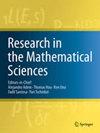The finite and solvable genus of finitely generated free and surface groups
IF 1.2
3区 数学
Q1 MATHEMATICS
引用次数: 2
Abstract
Abstract Let $${\mathcal {C}}$$有限生成的自由群和面群的有限可解格
抽象Let $${\mathcal {C}}$$ C是伪变种 $${\mathcal {F}}$$ 所有有限群的F或伪簇 $${\mathcal {S}}$$ 所有有限可解群的S,让 $$\Gamma $$ Γ要么是有限生成的自由群,要么是曲面群。The $${\mathcal {C}}$$ 的C属 $$\Gamma $$ Γ,用表示 $${\mathcal {G}}_{{\mathcal {C}}}(\Gamma )$$ gc (Γ),由有限生成残差的同构类组成 $$\mathcal C$$ C组G有相同的商 $${\mathcal {C}}$$ 选C。 $$\Gamma $$ Γ。我们展示了来自 $${\mathcal {G}}_{{\mathcal {C}}}(\Gamma )$$ G C (Γ)对所有素数p都是残差p。这回答了Gilbert Baumslag的一个问题,并证明了属中的群是剩余有限合理可解群。这就得到了Alexander Grothendieck问题的一个特殊情况的正解:如果F是一个自由群,则G是一个有限生成的残差 $${\mathcal {C}}$$ C组和 $$u:F\rightarrow G$$ u: F→G是一个同态,使得pro-的诱导映射 $${\mathcal {C}}$$ C完井 $$u_{\widehat{{\mathcal {C}}}} : F_{\widehat{{\mathcal {C}}}}\rightarrow G_{\widehat{{\mathcal {C}}}}$$ u C ^: F C ^→G C ^是同构的,那么u也是同构的。
本文章由计算机程序翻译,如有差异,请以英文原文为准。
求助全文
约1分钟内获得全文
求助全文
来源期刊

Research in the Mathematical Sciences
Mathematics-Computational Mathematics
CiteScore
2.00
自引率
8.30%
发文量
58
期刊介绍:
Research in the Mathematical Sciences is an international, peer-reviewed hybrid journal covering the full scope of Theoretical Mathematics, Applied Mathematics, and Theoretical Computer Science. The Mission of the Journal is to publish high-quality original articles that make a significant contribution to the research areas of both theoretical and applied mathematics and theoretical computer science.
This journal is an efficient enterprise where the editors play a central role in soliciting the best research papers, and where editorial decisions are reached in a timely fashion. Research in the Mathematical Sciences does not have a length restriction and encourages the submission of longer articles in which more complex and detailed analysis and proofing of theorems is required. It also publishes shorter research communications (Letters) covering nascent research in some of the hottest areas of mathematical research. This journal will publish the highest quality papers in all of the traditional areas of applied and theoretical areas of mathematics and computer science, and it will actively seek to publish seminal papers in the most emerging and interdisciplinary areas in all of the mathematical sciences. Research in the Mathematical Sciences wishes to lead the way by promoting the highest quality research of this type.
 求助内容:
求助内容: 应助结果提醒方式:
应助结果提醒方式:


